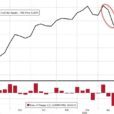
Here is the latest from the NY Fed:
The UIG “full data set” measure decreased from a currently estimated 3.10% in September to 3.07% in October.
The “prices-only” measure increased from 1.94% in September to 2.00% in October.
The twelve-month change in the October CPI was +2.5%, a 0.2 percentage point increase from September. The UIG measures currently estimate trend CPI inflation to be approximately in the 2.0% to 3.1% range. Both measures have declined modestly in the second half of the year reflecting the softening of the CPI.
Economists at the NY Federal Reserve Bank introduced a new measure of trend inflation in September 2017, the Underlying Inflation Gauge (UIG), meant to complement the current standard measures. Investors and policymakers alike have an interest in the behavior of inflation over longer time periods.
The trend component of inflation is not an observed measure and a proxy measure is required to calculate it. To calculate trend inflation, transitory changes in inflation must be removed such as volatile components or specific items. Core CPI, which is the most widely used and accepted form of estimating trend inflation, only focuses on price components. The UIG derives trend inflation from a large set of data that extends beyond price variables. Additionally, it has shown higher forecast accuracy than traditional core inflation measures.
Here’s what the NY Fed says about the UIG:
“…the design of the UIG is based on the premise that movements in trend inflation are accompanied by related changes in the trend behavior of other economic and financial series. Consequently, we examine a large data set to identify the common component of other economic and financial series and then focus on the persistent part of the common component.”
The UIG uses a dynamic factor model for large data sets and uses two different sets for calculations. The first is a disaggregated price data series in the CPI, called “prices only” and the second is the CPI disaggregated price series plus a wide range of macroeconomic and financial data, called the “full set”. The major difference between say, Core CPI data, and the UIG data is that the UIG adds instead of removes information that signal changes in trend inflation.
















